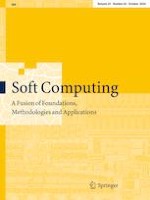18.04.2020 | Methodologies and Application
Frequency domain CNN and dissipated energy approach for damage detection in building structures
Erschienen in: Soft Computing | Ausgabe 20/2020
EinloggenAktivieren Sie unsere intelligente Suche, um passende Fachinhalte oder Patente zu finden.
Wählen Sie Textabschnitte aus um mit Künstlicher Intelligenz passenden Patente zu finden. powered by
Markieren Sie Textabschnitte, um KI-gestützt weitere passende Inhalte zu finden. powered by
